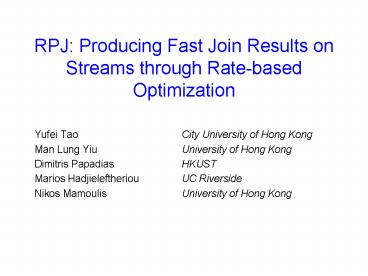RPJ: Producing Fast Join Results on Streams through Ratebased Optimization - PowerPoint PPT Presentation
1 / 19
Title:
RPJ: Producing Fast Join Results on Streams through Ratebased Optimization
Description:
Join the largest hash partition with the corresponding disk partition of the other relation. ... design of a stream-join algorithm includes deciding. the ... – PowerPoint PPT presentation
Number of Views:27
Avg rating:3.0/5.0
Title: RPJ: Producing Fast Join Results on Streams through Ratebased Optimization
1
RPJ Producing Fast Join Results on Streams
through Rate-based Optimization
- Yufei Tao City University of Hong Kong
- Man Lung Yiu University of Hong Kong
- Dimitris Papadias HKUST
- Marios Hadjieleftheriou UC Riverside
- Nikos Mamoulis University of Hong Kong
2
Problem
- R1 and R2 are two finite relations with a common
attribute A. - Their data arrive in the form of continuous
streams. - The goal is to return all the results of
- in a progressive manner.
3
Progressiveness
- Return as many results as possible in the same
amount of time. - Continue to return results even when data
transmission is blocked.
4
Processing Flow
5
XJoin(Urhan and FranklinData Eng. Bulletin 00)
- A tuple t of R1 arrives gt
- Probe the memory part of R2 gt
- Add t to the memory part of R1 gt
- Memory overflow?
- gt Flush the largest hash partition (of either R1
or R2) - Transmission blocked gt
- Join the largest hash partition with the
corresponding disk partition of the other
relation. - Still blocked?
- gt Repeat with the next largest.
6
Hash Merge Join (Mokbel et al. ICDE04)
- Differs from XJoin in
- Flush policy
- Flush all, largest, smallest, adaptive
- Action when transmission is blocked
- Joins two disk partitions using progressive
sort-merge join
7
Implications
- The design of a stream-join algorithm includes
deciding - the flushing policy
- the actions when the transmission is blocked.
8
RPJ (Rate-based Progressive Join)
- We assume that the received tuples reflect the
subsequent arrival distribuition. - Usually true when
- tuples arrive in a random order, and
- the join attribute is not the key of any
relation.
9
RPJ Flushing
- The flushing policy aims at maximizing the
probability that an arriving tuple produces a
join result with an in-memory tuple. - of join results produced by the arriving tuples
before the next flushing
10
RPJ Flushing (cont.)
- An example when the memory overflows
- If 1 tuple needs to be flushed
- we should flush a tuple of R2 with value 1.
- If only 2 tuples can be retained (i.e., flush 75
tuples) - we should only keep the 2 tuples of R1 with value
1.
11
RPJ Flushing (cont.)
- To flush 60 tuples, first remove all tuples of R2
with value 1 gt n2(1) 0. - Then flush 10 tuples of R1 with value 0 gt n1(0)
10.
12
Transmission blocked
- Motivation Joining two disk partitions may
actually produce faster results than joining a
memory and a disk partition.
13
Transmission blocked (cont.)
- Assume that each relation is hashed into m
partitions. - When the transmission is blocked, RPJ calculates
the expected output rate for each of the
following 3m choices - Joining the i-th memory partition of a relation
with the corresponding disk partition of the
other relation - Joining the i-th disk partitions of the two
relations. - Expected output rate is computed by maintaining
necessary statistics.
14
Experiments
- The domain of the join attribute the integers in
1, 10000. - Data distribution skewed.
- Memory large enough to hold 100k tuples.
- Flush 10k tuples each time.
- We test the impacts of the following factors
- Network reliability
- Arrival distribution
- Harmony
- Reverse
- Relative speed of the two streams.
- 11 both relations have 1 million tuples
- 15 one relation 1 million, the other 5 million
15
Experiment 1 Reliable Network
16
Experiment 1 Reliable Network (cont.)
17
Experiment 2 Unreliable Network
18
Experiment 2 Unreliable Network (cont.)
19
Future Work
- Join with a range predicate
- Multi-dimensional data
- Load shedding for dealing with limited memory































